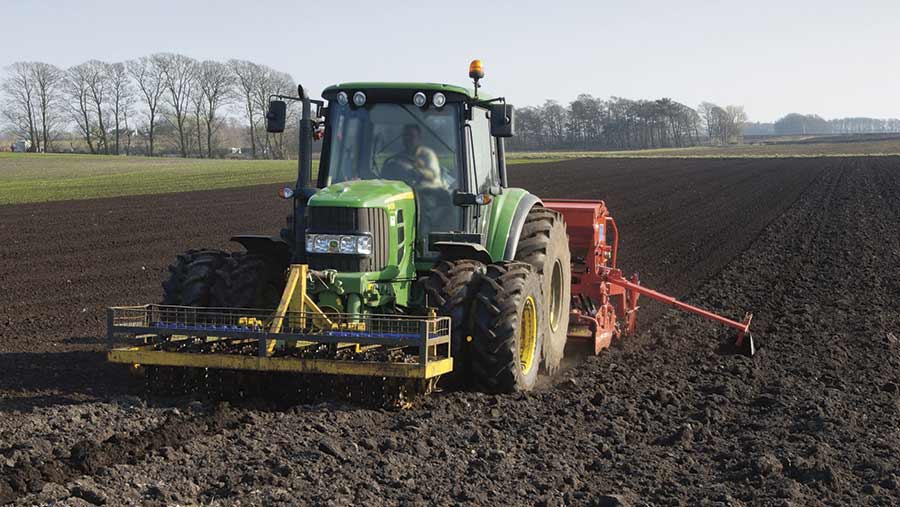Four growers share their crop cost-cutting plans

The high price of blackgrass means getting on top of herbicide-resistant blackgrass infestations is an essential part of managing costs, as well as streamlining machinery and labour costs.
While wheat prices in recent weeks have broken through the £140/t barrier, the weakening pound means input costs are rising and this will be the main challenge for farming businesses in 2017.
See also: Video: 4 growers share their tips to keep costs under control
Ammonium nitrate is 11% up on January 2016 and buying group Anglia Farmers has predicted a further 9.5% increase in aginflation in the coming year.
Arable margins are already slim, with one recent university report highlighting that more than nine in 10 winter wheat growers failed to cover their production costs in the bumper season of 2015.
Four growers outline their cost-control approach for the year ahead, as well as their successes last season, at a BASF-organised roundtable discussion.
Andrew Ward, Lincolnshire
Glebe Farm
- 660ha of cropping on a range of soils
- Cropping includes winter wheat, high oleic, low linoleic oilseed rape, sugar beet, spring barley and spring wheat.
Key cost-cutting approaches
- Reducing blackgrass levels to improve yields and slash herbicide spend
- Spring wheat replacing portion of spring barley
- Learn from other farmers
Spring wheat is a new addition to the rotation at Glebe Farm, as part of ongoing efforts to eradicate costly blackgrass.

Andrew Ward
The move to spring cropping is a key part of Andrew Ward’s no-nonsence approach to blackgrass, which also includes hand-rouging and glyphosating off infested patches.
“Our aim is that we don’t harvest any blackgrass and last season was the third year that no heads went through the combine,” he says.
Spring barley has been the key spring crop, but a poor performance last year led to the decision to replace a portion with spring wheat.
Last summer, oilseed rape was down 0.6t/ha on the average and wheat was slightly down.
However, the biggest disappointment was spring barley, which he described as “nearly an embarrassment”.
There were storms in late June/early July with 47mm of rain falling in one five-hour period, with 50mph winds when it was in full ear – and the crop went down.
This resulted in a yield of 8.1t/ha, compared with an average of 9.5t/ha, he says.
Mr Ward is switching to spring barley Irina, which is the top variety on the AHDB Recommended List in terms of lodging resistance with a rating of 8.
Spring wheat has been included for the first time this year and is being grown on category C fields (see panel) with the least blackgrass pressure, keeping the more competitive spring barley for the worst fields.
Three categories of fields
- No blackgrass – sandy soils with a rotation of sugar beet followed by spring barley, oilseed rape and winter wheat.
- Manageable levels of blackgrass – medium soils with a four-year rotation of sugar beet followed by winter/spring wheat or spring barley, then and oilseed rape, then winter/spring wheat or spring barley. The cereal option depends on the level of blackgrass control in the previous crop.
- High blackgrass levels – too heavy to grow beet and no winter wheat solely due to blackgrass. Rotation of oilseed rape, spring wheat/spring barley and spring wheat/spring barley.
The other spring crop, beans, is not good for blackgrass control, so the pulse is not grown on dirty fields.
His approach is proving successful with only 0.8ha being sprayed off last year, because it was unrougable, which compares with 73ha in his first year.
More importantly, his strategy means he is now spending £137/ha tackling the weed, including pre-emergence herbicides, two glyphosates and the rouging team.
This is less than £180/ha he previously spent, for some the herbicide cost is nearer £200/ha.
Ruth Stanley, BASF

Ruth Stanley
Lower numbers of blackgrass surviving the winter offers growers an opportunity to protect valuable ALS-inhibitor herbicides, while maintaining pressure on the weed.
Agronomists have reported that autumn herbicides have worked well and blackgrass numbers are generally much lower than last year, says BASF agronomy manager Ruth Stanley.
“There is an opportunity for those farmers planning spring applications of Atlantis (iodosulfuron + mesosulfuron) and Unite (flupyrsulfuron + pyroxsulam) to cut back and use a residual with a different mode of action instead.”
Keep Atlantis in the shed and use something else that will do that job, such as residual pendimethalin.
However, she adds that it’s crucial to keep the pressure on the weed, because the cost of blackgrass is high.
For example, a crop with 100 blackgrass heads/sq m equates to a 13% yield loss, and for a 10t/ha crop that’s a cost of £150/ha for a relatively small number of heads.
In a more severe infestation, of say 500 heads/sq m, there is a 63% yield penalty or £750/ha lost revenue.
“So there is a lot of money in blackgrass and it doesn’t pay to scrimp on pre-ems,” she concludes.
Pat Thornton, Doncaster
Low Melwood Farm
- 140ha of cropping on heavy, clay soils
- Cropping includes winter wheat, oilseed rape, spring wheat and spring barley
Key cost cutting measures
- Streamline kit and keep longer
- Greater use of contract labour
Streamlining machinery and labour is how Pat Thornton has managed to cut fixed costs on his 140ha farm near Doncaster.
His key challenge is that fixed costs are higher than benchmark values because of scale. Therefore, in a bid to reduce depreciation, he is keeping equipment for longer as well as using a neighbouring contractor for crop establishment.

Pat Thornton
He points to one useful indicator of machinery capital as used in Australia, termed the Machinery Income Efficiency ratio.
“Effectively, it is your total machinery assets divided by farm output (four-year average) and is a useful guide on how much capital outlay your business is carrying.”
The most profitable farms tend to run, on average, a machinery income efficiency around 0.7. Those with the highest total debt levels tend to be around 1.1.
Mr Thornton’s farm is now at 0.85. “There is no point having kit just in case we need it,” he says.
Moving to more spring cropping in a bid to tackle blackgrass has also helped reduce labour needs, by spreading the workload.
He introduced spring wheat two years ago, as it was proving prohibitive to grow second winter wheats because of the soaring cost of blackgrass control.
However, one issue with spring wheat has been the increased risk of ergot, due to the more open flowers on spring types.
To reduce risk, he has eliminated some ELS margins, because they acted as a reservoir of infection, and this spring he is trying a KWS variety to further reduce it.
Jack Storey, Northumberland
Saltwick Farm
- 394ha of combinable cropping, including high erucic acid oilseed rape, winter feed barley and winter wheat
Key cost cutting approaches
- Maximise yields to spread costs
- Target yield of 12.5t/ha
Maximising crop yields remains an important part of cutting costs, as one Northumbria farmer found in 2016.
Jack Storey saw the indirect costs of blackgrass first hand, as the result of a delayed T0 fungicide spray.
He highlights three fields of JB Diego second wheat, two of which did not receive any autumn herbicides because of the weather.

Jack Storey
“We do have [resistant] blackgrass, but it is not severe,” he says.
So last spring, conditions meant that the Atlantis (iodosulfuron + mesosulfuron) spray was later than anticipated.
So in order to avoid any risk of scorch with other products in the tank mix, and on the advice of his agronomist, he went with Atlantis plus a holding spray of epoxiconazole.
Then five days later, it received a T0 of Sinconil (chlorothalonil) and Vareon (prochloraz + proquinazid + tebuconazole).
Then come harvest, the two fields were 2t/ha down and the delayed T0 was the only variable.
Looking ahead, his aim is to raise yields, seeing local farmer Rod Smith as an inspiration. Mr Smith is the current wheat record holder and achieved 16.52t/ha.
“It illustrates what can be done in our area.” Mr Storey says.
“If we can get 12.5t/ha, the impact on the business would be to bring costs down to a sensible level and we can then make a surplus.”
What is ‘Costs Under Scrutiny’?
On the back of the increasing cost pressures in 2016, there was an increasing need to tackle cost while at the same time maximising yields.
To help farmers, BASF organised two roundtable meetings with progressive farmers sharing their cost cutting successes.
One year on, four of the farmers met up last month to assess their cost-cutting success as well as how they are managing costs for the current season. Farmers Weekly had full editorial control of the report.

